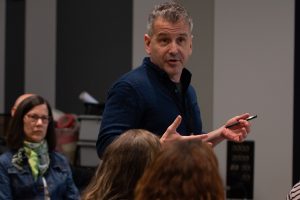If someone had sat you down eight or so years ago and told you that they were developing a hip-hop musical about Alexander Hamilton, you would have laughed and not believed them. This in fact was the reception Lin-Manuel Miranda experienced when he announced the project and performed a sketch of the production that was to come at the White House in front of President Obama and his wife Michelle. It is worth noting that at the conclusion of that presentation, the entire room leapt to their feet and cheered.

The Atlantic Theater Company world premiere production of The Band’s Visit by David Yazbek & Itamar Moses, based on the screenplay by Eran Kolirin, directed by David Cromer. Photo by Ahron R. Foster.
I am sure that a similar skepticism greeted book writer and lyricist Brian Yorkey and composer Tom Kitt when they first pitched the idea of Next to Normal. In the Wikipedia encapsulation of the show, it is cited as being about a woman facing “bipolar disorder and the effects that her illness and its management have had on her family.” The entry goes on to say that the piece “…also addresses the issues of grief, suicide, drug abuse, ethics in modern psychiatry and the underbelly of suburban life.” [source] Sounds like a great evening at the theatre doesn’t it? And yet Next to Normal went on to be nominated for eleven Tony Awards, winning three in addition to claiming the 2010 Pulitzer Prize for Drama.
Why? Next to Normal has an enormous capacity to emotionally engage. I hear rumblings from time to time that audiences are tired of dramas surrounding dysfunctional families. The trouble with functional families is of course that they don’t make very good subject matter for drama. The nature of drama is the theatrical exploration of conflict, and the most personal relationship we can craft with drama is probably found in our own homes. Sophocles certainly thought so when he wrote Oedipus as did Shakespeare when he wrote Hamlet. Furthermore, like the most successful of such dramas, Next to Normal tackles undiscovered country in dealing with bi-polar disorder in a musical vernacular and it uses songs to lift the subject matter into as many hearts as are willing to open.

Pictured: (L-R) J. Robert Spencer as Dan and Alice Ripley as Diana at Arena Stage in Crystal City through January 18, 2009. Photo by Joan Marcus.
The stigma of mental disorders is still very much with us. There is a sense sometimes when we learn that someone is suffering from depression that they are displaying a form of weakness, that if they’d only try harder, they could change their mood and attitude, and that surely they can just take a pill and everything would clear up. These attitudes are often coupled with misogynist tropes when it comes to women, in particular—frequently we hear that they are just being hysterical or overly emotional. The reality is much more complex and ambiguous and challenging. Next to Normal takes us into the heart of a normal suburban home, Glencoe for instance, and opens up a brilliant and compelling conversation about a family dealing with the crisis and stigma of mental challenges and sears it right into our souls. We laugh, cry, mourn and celebrate as we ride through the mountains and valleys of familial strife and we take home an astonishing array of songs in our heart.

Pictured: David Cromer. Photo by Tom McGrath.
Last year, when I had a conversation with David Cromer, one of my most trusted colleagues and dearest friends, as he was triumphing in New York with his brilliant production of The Band’s Visit (for which he and the show would go on to win well deserved Tony Awards and most recently a Grammy), we both acknowledged that mental illness had touched our lives personally and profoundly. I had myself stood upon the precipice of self-harm and contemplated making the jump. He, a good doctor, my best friend Scott Parkinson, my partner Jack and many in my life had helped me find an alternative way forward: life. We look for ways to echo the experiences we face in our art, and collaborating on Next to Normal seemed a superbly appropriate way of manifesting this conversation onstage.
David is one of the greatest directors of our generation. I have been following his art since I first became aware of him as a director. Perhaps a few of you will remember his first engagement with Writers Theatre back in the early days when he directed me in a one-man show about Lord Alfred Douglas, Oscar Wilde’s much maligned and very damaged lover. I had been recommended him by Curt Columbus and thus began a friendship that endures to this day. David always makes me see a play I thought I knew with fresh eyes. When it’s my first experience with the play, I never forget the staging and I usually hold up subsequent productions to his in unfair comparison. That’s how it is for me, at least. If you’re seeing David’s work for the first time, it’s possible you won’t notice the direction because you’ll be too busy immersing yourself in the lives of the characters in this wonderful musical. I once heard him say that he believes the director’s job is to take the audience and the play closer and closer together and at the last minute, get out of the way so that they can meet.
It gives me great pleasure to facilitate that process and introduce you all to Next to Normal. I hope you like each other.


No comments yet.